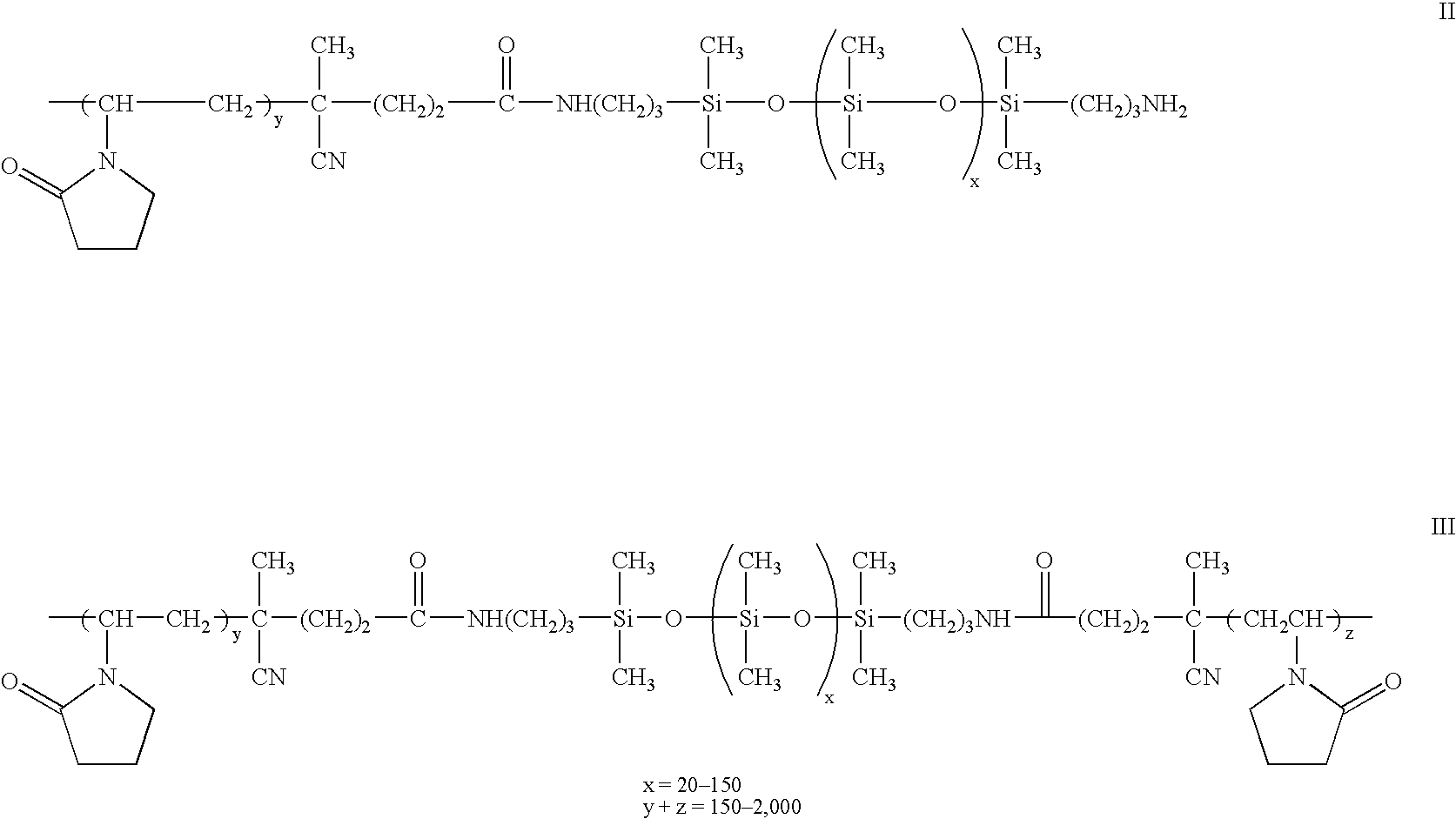Biomedical devices containing amphiphilic block copolymers
a technology of amphiphilic block and copolymer, which is applied in the field of silicone hydrogels, can solve the problems of increasing the cost and time it takes to produce these lenses, causing users to be uncomfortable, and polymer may be difficult to solubiliz
- Summary
- Abstract
- Description
- Claims
- Application Information
AI Technical Summary
Benefits of technology
Problems solved by technology
Method used
Image
Examples
example 1
[0097]9-Vinylcarbazole (0.79 gm, 4.1 mmol) (Aldrich, Milwaukee, Wis.), 2,2′-Azobis[N-(2-carboxyethyl)-2-methylpropionamidine]tetrahydrate (0.16 gm, 0.46 mmol) (Wako Chemicals USA, St. Louis, Mo.) and freshly distilled N-Vinyl-2-pyrrolidone (NVP) (15.1 gm, 136 mmol) were added to a 250 mL round bottom flask equipped with magnetic stirrer and nitrogen inlet. Methyl alcohol (19.2 gm) and distilled water (23.4 gm) were added to the reaction mixture. The mixture was degassed using 3 freeze-pump-thaw cycles and then allowed to warm to ambient temperature. The reaction mixture was heated at 60° C. for 16 hours, then precipitated three times using acetone as a solvent to yield a white polymer with Mn, Mw, and polydispersity values of 166,000, 420,000, and 2.6, respectively. Molecular weights were measured by gel permeation chromatography (GPC) using poly(2-vinylpyridine) standards and hexafluoroisopropanol as mobile phase. 1H NMR (D2O): delta=7.0-8.2 (bm, 8H, carbazole aromatic H), 3.4-3.8 ...
example 2
[0098]9-Vinylcarbazole (Aldrich, Milwaukee, Wis.) (1.9 gm, 9.6 mmol), 2,2′-Azobis[N-(2-carboxyethyl)-2-methylpropionamidine]tetrahydrate (Wako Chemicals USA, St. Louis, Mo.) (0.56 gm, 1.4 mmol) and freshly distilled N-Vinyl-2-pyrrolidone (NVP) (52.8 gm, 475 mmol) was added to a 1 L round bottom flask equipped with magnetic stirrer and nitrogen inlet. Methyl alcohol (231.4 gm) was added to the reaction mixture. The mixture was degassed using 3 freeze-pump-thaw cycles and then allowed to warm to ambient temperature. The reaction mixture was heated at 60° C. for 4 hours, then isolated by precipitation (3 times) into diisopropyl ether to yield a white polymer with Mn, Mw, and polydispersity values of 30,000, 110,000, and 3.7, respectively, using poly(2-vinylpyridine) standards and hexafluoroisopropanol as mobile phase.
example 3
[0099]N-vinyl-2-pyrrolidone (NVP) (Aldrich, Milwaukee, Wis.) (38.6 gm, 347 mmol), 9-vinylcarbazole (Aldrich, Milwaukee, Wis.) (0.68 gm, 3.5 mmol), VPS-0501 PDMS (5,000 MW) macroinitiator (Wako Chemicals USA, St. Louis, Mo.) (1.9 gm, 0.38 mmol), 1,4-dioxane (70.3 gm), and 1-octanol (30.8 gm) were charged to a 500 mL round bottom flask equipped with magnetic stirrer and nitrogen inlet. The reaction mixture was subjected to 3 freeze-pump-thaw cycles and then heated at 70° C. for 21 hours. The clear reaction mixture turned slightly hazy during the reaction. The polymer was isolated by precipitation into diisopropyl ether (three times) to afford 33.4 gm (85 percent) of a white solid with Mn, Mw, and polydispersity values of 56,000, 186,000, and 3.3, respectively, using poly(2-vinylpyridine) standards and hexafluoroisopropanol as mobile phase.
PUM
| Property | Measurement | Unit |
|---|---|---|
| weight percent | aaaaa | aaaaa |
| molecular weight | aaaaa | aaaaa |
| average molecular weight | aaaaa | aaaaa |
Abstract
Description
Claims
Application Information
 Login to View More
Login to View More - R&D
- Intellectual Property
- Life Sciences
- Materials
- Tech Scout
- Unparalleled Data Quality
- Higher Quality Content
- 60% Fewer Hallucinations
Browse by: Latest US Patents, China's latest patents, Technical Efficacy Thesaurus, Application Domain, Technology Topic, Popular Technical Reports.
© 2025 PatSnap. All rights reserved.Legal|Privacy policy|Modern Slavery Act Transparency Statement|Sitemap|About US| Contact US: help@patsnap.com



